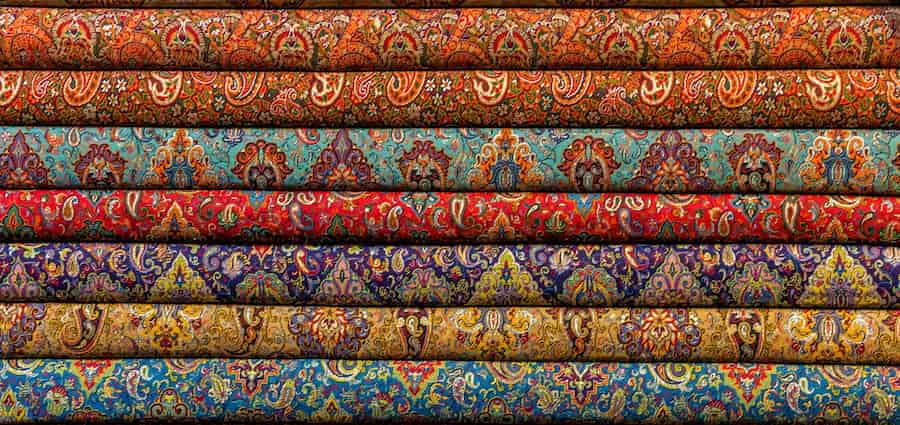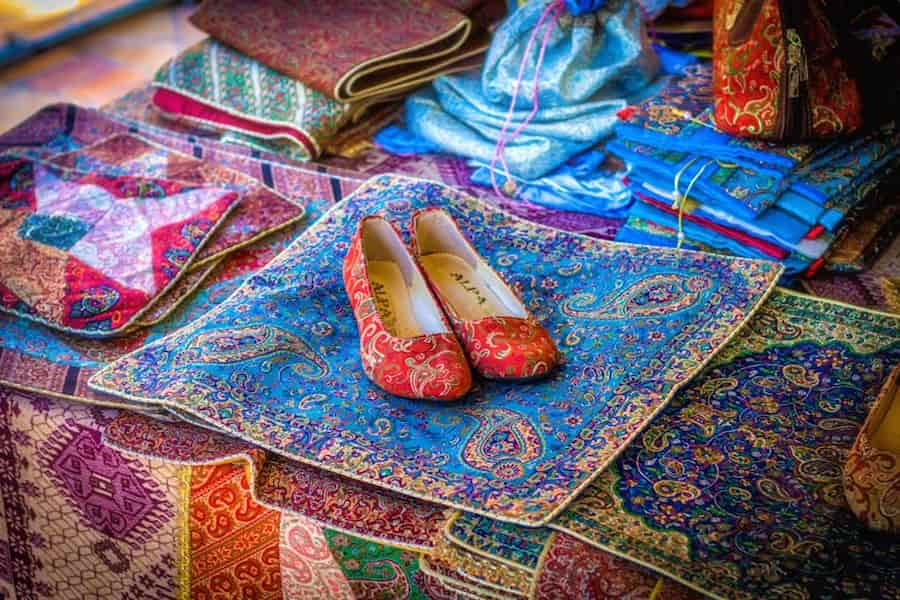Termeh is a fabric that is considered an artwork with a traditional design. The art of weaving termeh has been backed to hundred years ago when termeh was used just by the royal family. The fabric known as termeh is considered to be of the highest quality and features intricate patterns that have been passed down through the generations. Many people, from all walks of life and of various social levels, regard it as a kind of wonderful piece of art for their own personal use or as a present to others, particularly newlywed couples, because they feel that it brings luck and happiness. The natural silk or wool fibers that are used to make this fabric are bleached and colored so that they may be spun into the fine threads that are required to make termeh. In most cases, this fabric is woven using a four-way foundation, which ensures that the weft threads are sufficiently dense while still allowing them to move freely toward the rear of the cloth. A type of opulent fabric known as termeh, was traditionally utilized in the production of upscale garments. In modern times, it is most frequently utilized for the production of tablecloths, bedspreads, and prayer mats. One of the most exquisite examples of traditional Persian handicraft is referred to as a "termeh," and it is a one-of-a-kind piece of fabric that is typically constructed out of either silk or wool. This fabric's price will go up, and its value will go up even further after some unique designs of Sermeh embroidery are embroidered on it. The termeh of Isfahan is a type of fabric that is available to purchase and is known for its superior quality. 
termeh fabric and design
One good illustration of the unique design of termeh fabric would be the woven and embroidered Kerman's shawls. The pateh-doozy or pateh-duzi, also known as the embroidered shawl of Kerman, is created by employing a backdrop cloth referred to as shal, which is the origin of the English word shawl. The shawl is typically woven using a twill weave, and the most popular color of the base cloth is red. However, as we can see from the photographs here, the shawl may be woven using a wide range of other colors as well. The design for the shawl is pounced over the surface of the foundation cloth using carbon (coal dust) dusted over perforated parchment. The pattern for the shawl is stitched on the base fabric. A pen is used to further clarify the outline made by the carbon dust. Following the texture of the twill weave with their stitching, some embroiderers created the technique that produced a patterned shawl that could easily be mistaken for a more expensive woven shawl. The termeh reflection refers to a certain kind of delicately embroidered silk shawl known as an aksi. The pattern is only stitched on one side of the shawl; however, by cutting the warp thread in half, an image that appears to be "reflecting" is created on the other side of the shawl. Expert embroiderers are becoming increasingly rare, much like the weavers before them. In the modern-day, the Kermani village of Hudk is home to a small number of embroiderers who have managed to keep their craft alive.
 termeh fabric art
termeh fabric art
Producing termeh is an art form that demands two distinct skill sets, the first of which is product and design, and the second of which is weaving. Goushvareh-kesh is the title given to the person who does the weaving. One weaver may be able to integrate multiple skill sets, such as in folk weaving; however, as the product becomes more complex, it requires two or more people to work together as a team in order to manufacture termeh. Weaving complex patterns is a time-consuming procedure; in certain instances, just 25 to 30 cm of fabric can be weaved in a single day. Producing termeh is an art form that demands two distinct skill sets, the first of which is product and design, and the second of which is weaving. Goushvareh-kesh is the title given to the person who does the weaving. One weaver may be able to integrate multiple skill sets, such as in folk weaving; however, as the product becomes more complex, it requires two or more people to work together as a team in order to manufacture termeh. Weaving complex patterns is a time-consuming procedure; in certain instances, just 25 to 30 cm of fabric can be weaved in a single day. The production of termeh was done in small batches in home kitchens. Each person's house would have had its own loom, and every member of the household would have participated in the weaving process. It is likely that the structure of the looms, the procedure used to make a thread, the designs and patterns, and the vividness of the colors generated by various dyes were all closely guarded family secrets. This illustrious heritage is currently in jeopardy. Producing the piece of cloth or the sheet of fabric can take anywhere from a few days to several months. There is no way that the prices achieved can effectively compensate for the high costs associated with this labor-intensive skill. When a family gives up its long-standing history of weaving, all of its information, expertise, and trade secrets will be lost for good. Without wealthy customers, the craft will eventually go extinct. 
termeh fabric line
When it comes to valuable termeh especially when is woven with valuable threats like silk or even gold and silver the weavers line the fabric to increase its durability of it. But the following factors determine how much something is worth in termeh. The thread's and fiber's degree of fineness, as well as their overall quality. The addition of gold and silver contributes significantly to a rise in value. The amount of different colored threads that were utilized to weave the fabric. The value increases as the number of colors in the pattern increase. Termehs with a lot of detail might contain anything from two hundred to three hundred different colored threads. The number of individual layers that make up the cloth; a higher layer count results in a higher score. The adding of a border, along with making the existing boundaries wider. Embroidered designs typically offer less value to an item than finely woven designs. A name given to the intricately stitched designs: sermeh doozy. Printed designs contribute the least to overall value. The one-of-a-kind character of the layout. 
termeh fabric pattern
The boteh, often written botteh, a motif is one of the most common design motifs linked with the termeh fabric. The term "paisley design" is one that is used to refer to this pattern the most frequently in western culture. The history of the boteh motif, termehs (and fact, Persian carpets as well), and Aryan trade are intricately tied to one another and have a close relationship with one another. Checkered or honeycomb-like patterns can be used as the design for tablecloths. Both of these patterns are common. Other design patterns include stripes of varying widths, the Atabaki pattern, and the Zomorrodi pattern, which was mostly colored green and featured a variety of other colors as accents. Some of the image patterns that are popular among Yazdi Zartoshti women who participate in Zartoshti-doozy (Zoroastrian needlework and embroidery) include the tree of life, the cypress tree, the juniper tree, clove, the four or eight petal jujube, peacocks, roosters, hens and chicks, hoopoe, fish, and geometric shapes such as circles and There is a link that can be seen between the Zoroastrian folk patterns for women's pantaloons and the striped pattern that can be found on Kermani scarves and termehs. These patterns both use several colors in their designs. The striped patterns can be thin or wide, show a subdued color palette, and feature a brilliant assortment of colors.

0
0